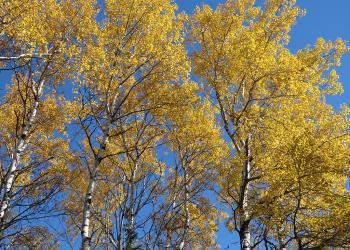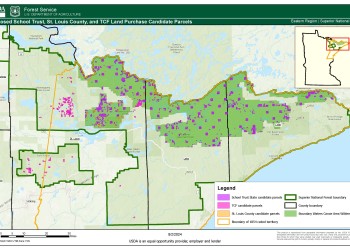Forest Management
The Superior NF lies within the transition zone between the boreal forests to the north and the broadleaf deciduous forests to the south.
Forest Vegetation
The northern forest provides habitat for numerous wildlife species as well as use and enjoyment by the American people including economic opportunities in the form of pulpwood and saw timber for the forest products industry, traditional uses, and a highly desired vacation destination for the tourism industry.
Vegetation is the result of climate, soils, landforms, and natural disturbances in the 18th century, exploitive logging during the late 19th century, followed by widespread slash-fueled wildfires in the 20th century and more recently, fire suppression. and vegetation management activities
The forested region of northern Minnesota is a mosaic of forest communities ranging from relatively pure stands of hardwoods (mainly birch, maple, and basswood) in areas with relatively nutrient-rich soils to relatively pure stands of conifers (mainly pine) in areas with relatively nutrient-poor soils. Between these two extremes are a variety soil types and habitats, which produce mixed stands of conifers and hardwoods.
The dominant landscape forest communities include:
- Jack pine
- Red pine
- Red and white pine
- Mixed boreal hardwoods and conifers
- Northern hardwoods
- Aspen, birch, and spruce-fir
- Conifer bogs composed of black spruce, tamarack, or white cedar
Smaller-scale Landscapes
Embedded within these forested landscapes are smaller-scale native plant communities, such as black ash swamps, riparian forests, forested bogs and fens, barrens, shrub swamps, and sedge meadows.
Development of Forest Communities
The patterns of dominant forest communities in northern Minnesota are largely a product of climate, geology, soils, topography, and a variety of disturbance factors. Historically, fire and wind have been the primary natural disturbance factors shaping forest vegetation patterns in this area. Floods, insects, and disease also influenced forest vegetation.
The compositional and structural characteristics of forest vegetation at both the landscape and stand levels shift through time in response to both natural and human-induced disturbances. For instance, the size, amount, and spatial arrangement of dominant forest vegetation types, early successional vegetation, and old-growth forest at the landscape-scale changed from decade to decade. These shifts in landscape patterns are primarily in response to stand-replacement disturbance events.
Similarly, the composition and structure of the understory, midstory, and overstory of individual stands are shaped by more local, less severe disturbance events. Less intense, more localized disturbance events, such as low intensity ground fires, small-scale wind events, and localized insect and disease outbreaks, influence individual stand characteristics, such as crown closure, canopy gap creation, understory and midstory development, and the availability of snags and downed woody material.
Arrowhead Pilot Project

A collaborative approach to forest landscape management begins with a shared sense of responsibility, and a common approach that leads to more significant outcomes.
Lands and Realty Management

The Forest Service Lands and Realty Management Program secures and protects the American public's rights, title, value, and interests in its national forests and grasslands and authorizes a variety of uses on those lands to meet the needs of present and future generations.
Minerals Resource Management

In recent years, there has been increased exploration and interest in the Duluth Complex which underlies a significant portion of the Forest.
School Trust, St. Louis County and TCF Lands Purchase

After reviewing public input and analyzing the projects, final decision(s) will be documented in Decision Memo(s). The Forest plans to make three separate decisions, one for each realty action:
- To purchase as many as 6,261 acres of TCF Lands - December 18, 2024
- To purchase St. Louis County State Tax Forfeit Lands (2026)
- To purchase School Trust/ Minnesota Department of Natural Resources Lands (2025)


